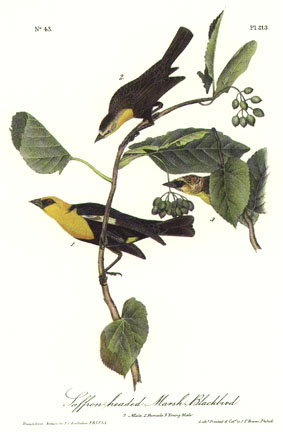

213 SAFFRON HEADED MARSH BLACKBIRD
| This species was first made known as an inhabitant of North America
by the naturalists of Major LONG's expedition to the Rocky Mountains.
According to Dr. RICHARDSON, "the species ranges in summer to about
the fifty-eighth parallel," but has not been found to the eastward
of the Mississippi, where it "arrives from the southward in the
middle of May, and by the 20th of the same month reaches the
Saskatchewan, where it associates with the Redwing, and, being more
numerous, commits even greater havoc in the corn-fields. Mr. NUTTALL has
favoured me with the following notice respecting it. "On the 2d of
May, around the Kansa (Texian) Agency, we now saw abundance of the
Yellow-headed Troopial, associated with the Cow-bird. They kept much on
the ground in companies, the males (at this time) by themselves. In
arable or loose soil they dig into the earth with their bills in quest
of insects and larvae, are very active, and straddle about with a quaint
gait, and now and then, while on the ground, which they wholly frequent,
in the manner of the Cow-bird, whistle out with great effort, a
chuckling note sounding like ko-kukkle-'ait, often varying into a
straining squeak, as if using their utmost endeavour to make some kind
of noise in token of sociability. Their music, if such it deserves to be
called, is however even inferior to the harsh note of the Cow-bird. Are
they also polygamous? Afterwards, in the month of June, by the edge of a
grassy marsh, in the open plain of the Platte, several hundred miles
inland, we met with the nest of this bird containing, several spotted
and blotched greenish-white eggs, not much unlike those of the
Red-winged Starling, Agelaius phoeniceus." To this Mr. TOWNSEND
adds:--"Agelaius xanthocephalus inhabits the western plains of the
Missouri and banks of the Platte river to the Black Hills. The nest of
this species is built under a tussock in marshy ground, formed of fine
grasses, and canopied over like that of the Meadow Lark. The eggs, from
two to four, are of a bluish-white, covered all over with minute specks
of purple, largest and most numerous at the great end. It associates
with the Cow Bunting, and alights on the backs of the horses. Its note
is very harsh and grating, and does not resemble that of the Red-winged
Blackbird."
I have represented a male, a female, and the head of a young bird approaching towards maturity. Western Plains, California, and Fur Countries. Abundant. Migratory. YELLOW-HEADED TROOPIAL, Icterus icterocephalus, Bonap. Amer. Orn.,
vol. i.p. 27. AGELAIUS XANTHOCEPHALUS, Saffron-headed Maize-bird, Swains. and Rich. F. Bor. Amer., vol. ii. p. 281. YELLOW-HEADED TROOPIAL, Nutt. Man., vol. i. p. 176. YELLOW-HEADED TROOPIAL, Icterus xanthocephalus, Aud. Orn. Biog., vol. v.p. 6. Adult Male, 9; wings, 5 10/12. Bill shorter than the head, stout, straight, conical, tapering to a fine point; upper mandible with the dorsal line nearly straight, being slightly convex at the base, the ridge a little flattened toward the base, where it runs into a short tapering process, the sides rounded, the edges inflected, the tip a little depressed; lower mandible rather higher at the base than the upper, with the angle short and wide; the sides convex at the base, toward the end rounded, the edges involute, the tip acute; the gap-line straight, but at the base deflected. Nostrils oval, in the fore part of the short nasal depression. Head of moderate size, ovate, with the forehead flattened; neck short; body moderately stout. Feet of ordinary length; tarsus rather stout, compressed, with seven large anterior scutella, and two lateral plates, meeting behind at an acute angle; toes rather large, compressed, the first much stronger, the outer a little shorter than the inner and united with the third as far as the second joint; claws long, little arched, compressed, laterally grooved, very acute. Plumage soft, blended, glossy; the feathers generally ovate; those on the upper part of the head stiffish and somewhat silky. Wings of ordinary length, the first, second, and third quills almost equal, the second being longest; outer secondaries slightly emarginate. Tail rather long, rounded, the lateral feathers four-twelfths of an inch shorter than the longest. Bill and feet black; iris hazel. The head, the upper part of the hind neck, the fore neck and part of the breast, orange-yellow, the throat paler; the feathers along the base of the bill, the loral space, a band below the eye, and a narrower one above it, black. The rest of the plumage is glossy black, excepting two bands on the outer part of the wing, formed by some of the smaller coverts, and the primary coverts, which are white. Length to end of tail 9 inches; bill along the ridge 10/12; wing from flexure 5 10/12; tail 4 4/12 tarsus 1 5/12 hind toe 7/12, its claw 8/12; second toe 8/12, its claw (5 1/2)/12; third toe 11/12, its claw (5 3/4)/12; fourth toe (7 3/4)/12, its claw 5/12. Female. The female, which is much smaller, is of a uniform greyish-brown colour, with the feathers at the base of the upper mandible, a band over the eye, and the fore part of the neck light yellow; the throat dull white, and the feathers on the middle of the breast margined with white toward the end. The bill and feet are dusky brown. Young. The head represented is that of a young male assuming the plumage of the adult.
|